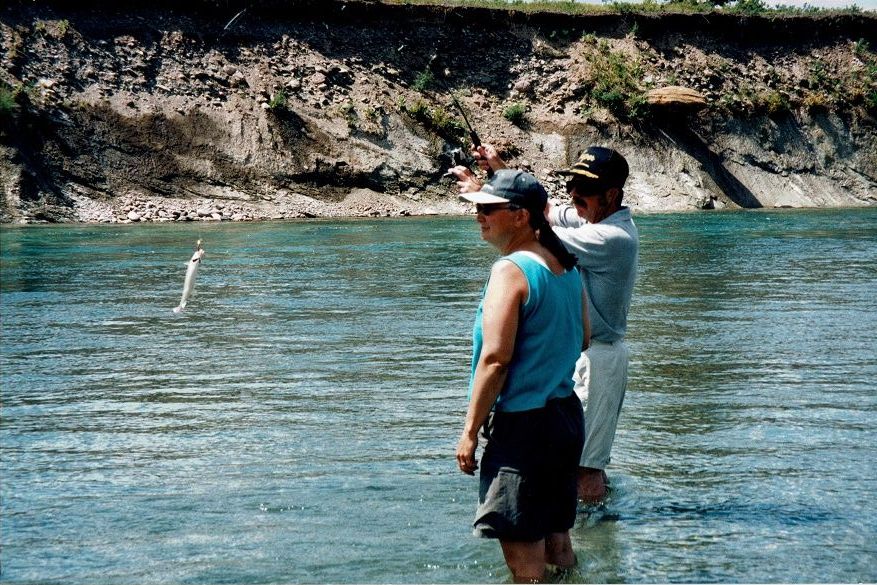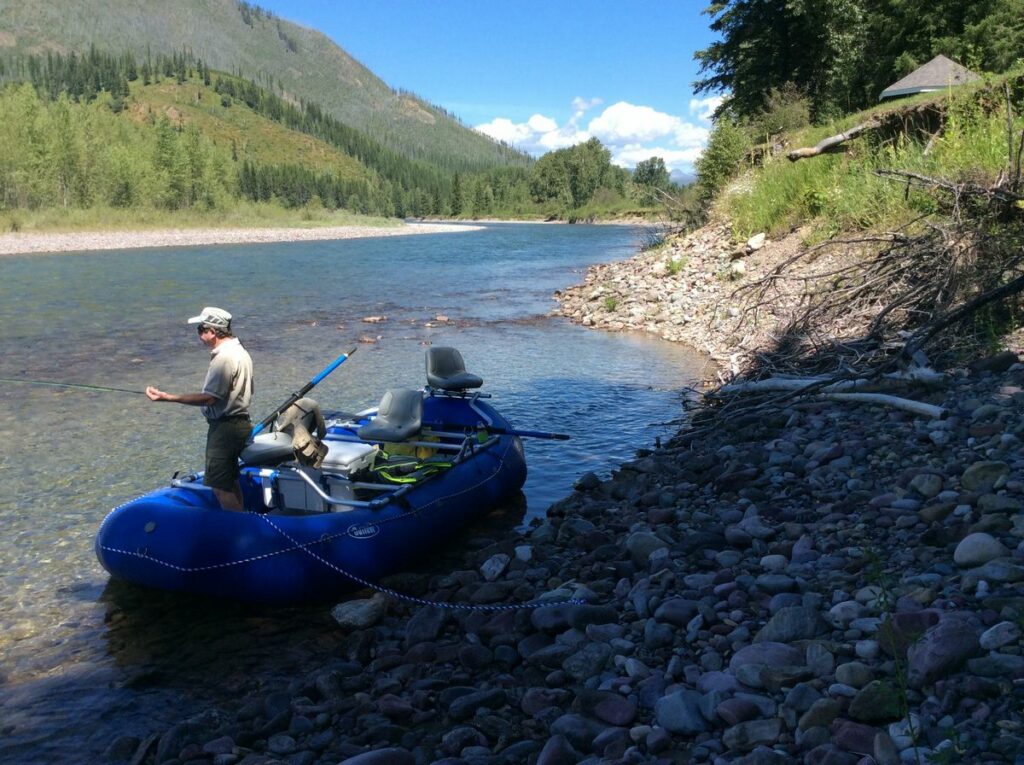Hiring a Montana Trout Fly Fishing Guide
One of the best ways towards a successful fly fishing trip to Montana is to hire a Montana Trout Fly Fishing Guide.

The benefits that a fly fishing guide can offer:
- Knowing the insect hatches: Yes, Montana is full of big trout, but the way these trout get so big is intelligence. They know which insects are hatching, the color and size they are, and how they float on the water. Equally knowing this information is exactly what a guide is paid to do. When fishing this clever species, you need to have everything near perfect and a guide will be your secret weapon.
- Where to fish: Trout have certain conditions that they prefer. Fishing in the right spot is a crucial factor of success on trout water. Insects and other organisms that trout feed on collect in certain areas and this is where you will find trout, often big trout. An experienced Montana fly fishing guide will be able to position you in the right place at the right time.
- Access: Getting to trout-filled waters is sometimes half the battle. Much of Montana’s trout fishing is best accessed by a boat or by trekking your way in. Of course, not everybody has a boat and even if you do, it may not be feasible or possible to get through the terrain. A guide will know the best way to get you where you need to be.
- Equipment: Many guides will offer high quality gear, a fly fishing rod, a reel and line designed to cast the flies more effortlessly and on target. Like most things, using the right equipment will greatly improve your fly fishing efficiency and success.
- Knowledge: A Montana trout fly fishing guide will be able to offer clients so much more than just fishing advice. A good guide also knows the history, geology, anthropology, and stories that make this part of the world so interesting and beautiful.
Gear to Bring:
Many Montana rivers can be demographically demanding, both for fly fishing gear and clothing. To make this the best trip possible it is advised that you come prepared for anything that Montana can throw at you. Temperatures can unexpectedly drop, terrain can be challenging, and the fish can be larger than expected. Let’s go over some items you should not be without.

Fly Fishing Gear: Things you will need, especially if not hiring a Montana Trout Fly Fishing Guide
Fly Fishing Rod: It is very important that you bring a quality rod. Inexpensive combo sets are not recommended and will lead to potentially enough frustration to damper your fishing expedition. A well-made fly rod is much easier to cast, more accurate, and stronger. Two rules of thumb are; buy the best rod you can afford, and a rod with an extended warranty (depicting the manufacturer’s faith in their equipment).
Fly Fishing Line: Fly lines are a close second to the importance of a quality fly rod. With fly fishing, you are casting the line which delivers the fly to where you want it. This means the line must work effortlessly with the rod. Also, you will want to be able to fish many different situations as the fish are not always willing to take an insect on the top of the water. You may need to use a sink tip to get bait imitations below the surface, therefore it’s wise to go with a line that is interchangeable with different sink rates, from floating to quick sink.
Fly Fishing Reel: A fly reel is less important during the cast and receives less use than the line and rod, but a smooth drag system is very helpful if you hook a trout 16 inches or larger. It is not a good experience to lose the catch of a lifetime over inexpensive equipment. Again, it is suggested to buy the best reel you can afford, but if you must skimp on either a rod, reel, or line, this is the place to do it.
Waders and Boots: These are an essential. Although they may cost twice as much, quality boots and waders can last three or more times as long before the seams start leaking. Also, a good pair of boots is a must on slippery rocks, which is not uncommon in rivers. Good support and traction are important. There are many types of soles to choose from. Naturally, good rubber soles opposed to felt cut down on transporting invasive aquatic organisms that may otherwise survive. Nearly all quality wading boot manufactures have come out with rubber soles designed to grip slippery rocks and many have removable cleats that can improve your traction.
Flies, leaders, tippets, floatant, and line cutters: These are all necessary and important, especially knowing how they interact with each other. One would think trout would take any fly that it sees, but even young fish are smart and will mostly only take flies that match the insects that are hatching at the time.
Things to bring, guide or not:
Hiring a Montana trout fly fishing guide will reduce the amount of gear you will need to pack as far as fly fishing equipment. Still, there are several items that you will not want to leave home that you shouldn’t expect a guide to supply.
Here is a quick list of those items.
Rain proof coat: The weather in Montana’s mountains can change in an instant, from sunny and warm to cloudy, rainy, and sometimes even snow.
Binoculars: Montana is home to incredible wildlife, and you never know what you’re going to see; deer, elk, big horn sheep, moose, wolf, coyote, bears, and other species are all possible in an outing.
Camera: Make sure it’s handy, not only for the incredible wildlife and scenery but for when you reel in that giant fish.
Sunscreen: The sun is intense at these altitudes and the rays will reflect off the water.
Sunglasses: Sunglasses are very helpful when spending all day on the river. Polarized sunglasses are recommended as they cut down on the glare coming off the water and help you to see into the water much better than regular sunglasses.
Handling of Montana Trout
All trout are very delicate. It is best not to touch them at all, but if you do need to take a picture, wet your hands before touching it, take a quick photo, and get it back in the water. It is best to let it swim away as soon as it has the power to do so. Please do not caress it and rub its belly like you see them do on fishing shows. Get the trout out of your hand as soon as possible.
Most of Montana requires Barbless hooks because it is much easier to remove the hook. Barbless hooks have a reputation for losing fish, but this is often thought to be untrue. Generally, if a hook is coming out, it will come out barb or not (the key is keeping the line tight). Many experienced fly fishermen, including many fishing guides, will agree that the barb makes it harder to set the hook due to a wider shank. Of course, another argument against barbed hooks is the fact that it’s not smart to have a barbed hook flying around your head, or any part of your body for that matter.
Conclusion
No matter how many big trout you do or don’t catch, you are sure to have a memorable trip, the scenery alone is worth venturing to Montana.
Plan a long enough vacation because often, your trip will feel too short.
Please be respectful of the fish, the wildlife, the rivers and the landscape so that anyone coming after you can enjoy this magnificent land.
For more information about license requirements and fishing regulations, visit the Montana Fish, Wildlife and Parks website: https://fwp.mt.gov/fish
Or the Glacier National Park website: https://www.nps.gov/glac/planyourvisit/fishing.htm
Good Luck!

